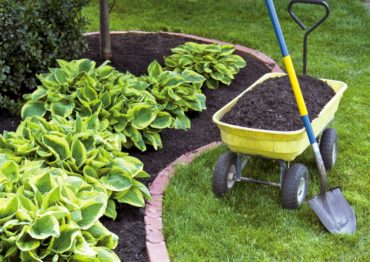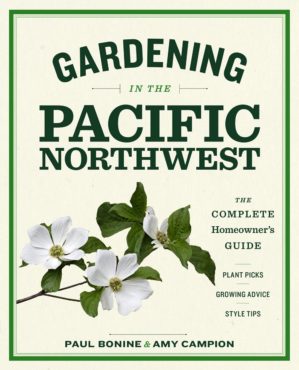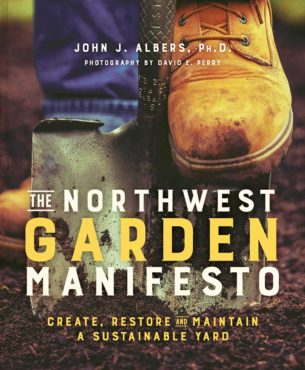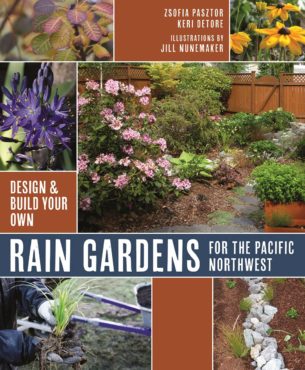 Now that spring is officially here and all the bulbs, annuals and shrubs are planted, perhaps there is time to breathe a little between pulling weeds and watering to do some garden reading. With the Pacific Northwest being a gardener’s paradise, expertise abounds, along with regionally specific gardening and nature books. Here are three in particular of local interest.
Now that spring is officially here and all the bulbs, annuals and shrubs are planted, perhaps there is time to breathe a little between pulling weeds and watering to do some garden reading. With the Pacific Northwest being a gardener’s paradise, expertise abounds, along with regionally specific gardening and nature books. Here are three in particular of local interest.
“Gardening in the Pacific Northwest: The Complete Homeowner’s Guide”
This concise book written by two regional garden experts is both an excellent introduction to Pacific Northwest gardening and a good resource for local old-hat gardeners. Written with local and regional climates in mind, it covers soil and cultural needs of the area and recommends various trees, shrubs, vines and perennials that will thrive there. Beautifully photographed and expertly written, this book is practical, useful and fun to randomly flip through after a good day of gardening.
 Authors Paul Bonine and Amy Campion are no strangers to Pacific Northwest gardening. Both have decades of experience in the nursery industry and are active garden communicators. Bonine has worked in the industry for over 25 years and is the co-owner of Xera Plants, a Portland, Oregon, nursery that emphasizes West Coast native plants and others from similar winter-wet and summer-dry. He lectures on gardening and has consulted for the “Sunset Western Garden Book,” the Oregonian newspaper and National Public Radio.
Authors Paul Bonine and Amy Campion are no strangers to Pacific Northwest gardening. Both have decades of experience in the nursery industry and are active garden communicators. Bonine has worked in the industry for over 25 years and is the co-owner of Xera Plants, a Portland, Oregon, nursery that emphasizes West Coast native plants and others from similar winter-wet and summer-dry. He lectures on gardening and has consulted for the “Sunset Western Garden Book,” the Oregonian newspaper and National Public Radio.
Campion spent 16 years in the wholesale and retail nursery industry. After moving to the Pacific Northwest, she continues to expand and share her horticultural knowledge and is active in the Hardy Plant Society of Oregon. A freelance writer, editor and photographer, she maintains a wonderful garden blog at amycampion.com.
“Gardening in the Pacific Northwest” is divided into three sections. The first covers regionally specific aspects of gardening in the area. Climate and weather on the east and west of the Cascades is considered along with typical soil types. Fertilizers, irrigation and pests and diseases are discussed to round things out.
The second and the largest section covers common and specialty plants that typically do well in the Pacific Northwest. Bonine tests plants at his nursery to determine their suitability and is an expert in this subject. Bloom time, size and regional preferences are given for each plant, along with handy descriptions. Accompanied by stunning photographs, this section is useful to new and experienced gardeners alike.
Finally, designing in Northwest garden styles completes the book. There are various styles presented. The common woodland type that fits right in west of the Cascades. The dry garden that may seem out of place but really meshes nicely with our dry summers on either side of the mountains.
Gardens with Japanese influence are common, owing in part to early influences of Japanese immigrants in Northwest horticulture. The Pacific Northwest is home to some famous North American Japanese gardens.
Covering local cultural factors, plants suited to our region and regional design factors, “Gardening in the Pacific Northwest” is well suited to the new or veteran gardener.
“The Northwest Garden Manifesto: Create, Restore and Maintain a Sustainable Yard”
For those sustainability minded gardeners, creator of the Albers Vista Garden John Albers has provided “The Northwest Garden Manifesto.” It is a compact yet information-dense book for those interested in maintaining their own gardens as sustainable extensions of nature in an urban environment. The author shows readers how their gardens can help mitigate some of the stresses placed on nature within the human environment.
 After an introduction to the function and importance of healthy ecosystems, an entire chapter is devoted to assessing one’s own yard or garden. Before launching headfirst into creating your own sustainable garden, it is important to determine the pre-existing plants, site characteristics and local climate factors. Albers lays out steps toward this goal, along with science-based information.
After an introduction to the function and importance of healthy ecosystems, an entire chapter is devoted to assessing one’s own yard or garden. Before launching headfirst into creating your own sustainable garden, it is important to determine the pre-existing plants, site characteristics and local climate factors. Albers lays out steps toward this goal, along with science-based information.
The next two chapters cover trees, shrubs, perennials, edibles and grass for sustainable gardens. Topics include plant selection, planting and maintenance, and there is a list of plants suitable for sustainable gardens.
Both native and nonnative species are encouraged. Nonnatives have their place, provided they are not invasive. Many nonnatives possess desirable characteristics, and carefully planned sustainable gardens need not be exclusively native.
Besides plants, gardens also use water, paths, raised beds and other materials. Two chapters are devoted to wise use of resources in a sustainable garden. From use of low-water plants, placement of plants by watering needs and selection of environmentally low-impact gardening equipment, to reducing, reusing or recycling building materials, many topics are described in a sustainability context. An introduction to water-wise irrigation helps make the subject manageable for those new to watering systems beyond hoses and sprinklers.
To be sustainable, a garden needs to be not only designed with sustainable plants and materials, it must be possible to care for it sustainably. Albers describes some crucial components of sustainable care regarding diseases, pests and weeds. Mechanical, cultural and biological controls are encouraged for reducing impacts on wildlife drawn to your garden. Pesticides are an absolute last resort if tolerating the damage is not an option.
“The Northwest Garden Manifesto” qualifies as one of the gardening “gospels” of this region, made even better by the fact that the author is from Kitsap County and maintains the Albers Vista Garden in Bremerton for West Sound residents and visitors to view sustainable gardening practices.
“Rain Gardens for the Pacific Northwest: Design & Build Your Own”
Continuing the thread of sustainability, “Rain Gardens for the Pacific Northwest” addresses a specific garden style that deals with a widespread urban problem: excess water runoff. With rapid growth and development in the region, urban growth has often outpaced treatment facilities’ ability to deal with stormwater overloads, contributing to water pollution and soil erosion in waterways, lakes and Puget Sound. Rain gardens are one part of dealing with this problem.
 Authors Zsofia Pasztor and Keri DeTore and illustrator Jill Nunemaker have put together a very thorough rain-garden handbook for gardeners, homeowners and anyone else who may need the information. Pasztor is founder of the nonprofit Farmer Frog (farmerfrog.org), owner of Innovative Landscape Technologies and an accomplished horticulturalist and arborist. DeTore is well versed in fine art, graphic design, public relations, landscaping and horticultural restoration and has her own business, Lens Communications. Nunemaker is an award-winning landscape designer and lifelong resident of the Pacific Northwest.
Authors Zsofia Pasztor and Keri DeTore and illustrator Jill Nunemaker have put together a very thorough rain-garden handbook for gardeners, homeowners and anyone else who may need the information. Pasztor is founder of the nonprofit Farmer Frog (farmerfrog.org), owner of Innovative Landscape Technologies and an accomplished horticulturalist and arborist. DeTore is well versed in fine art, graphic design, public relations, landscaping and horticultural restoration and has her own business, Lens Communications. Nunemaker is an award-winning landscape designer and lifelong resident of the Pacific Northwest.
Their book starts by discussing the need for rain gardens and then offering an introduction to hydrology, climate and soils to provide the reader with the background science necessary for building and designing an effective rain garden. For the book’s purposes, the Pacific Northwest is defined as Washington and the northern half of Oregon, including both western and eastern halves.
Next, the book covers site evaluation, planning and design. Everything the reader needs to know is explained, even legal aspects. Because rain gardens deal with stormwater, one or more regulatory bodies may be involved and the homeowner is not able to just install a rain garden at will.
The nuts and bolts of rain gardens are covered in detail to assist in proper planning. It is vital to plan rain gardens well so they can function as intended.
Rain-garden installation is explained step by step with very clear illustrations. The extremely well done photography, illustration and layout help make a complex process understandable for anyone.
As with any good garden-design book, maintenance needs pertinent to the garden style are included. The authors have conveniently broken this down to year-by-year instructions for the first three years after installation to help readers adjust maintenance needs with the growing garden.
While the book is geared for rain gardens, an entire chapter is devoted to other low-impact development (LID) techniques for those who may be interested in other stormwater mitigation practices. Bog gardens, rain barrels, cisterns, green roofs/walls and pervious surfaces can all have their place in stormwater management.
The book ends with case studies of successful rain gardens. This is useful for not only seeing how they work but also for design ideas. For those interested, a detailed list of rain-garden plants organized according to water needs is presented at the end to aid in planning and design.
“Rain Gardens for the Pacific Northwest” covers the topic of rain gardens in great detail while being easy to read and clearly and expertly illustrated. It is a must-have for anyone considering or planning to put in a rain garden of their own.

































Comments